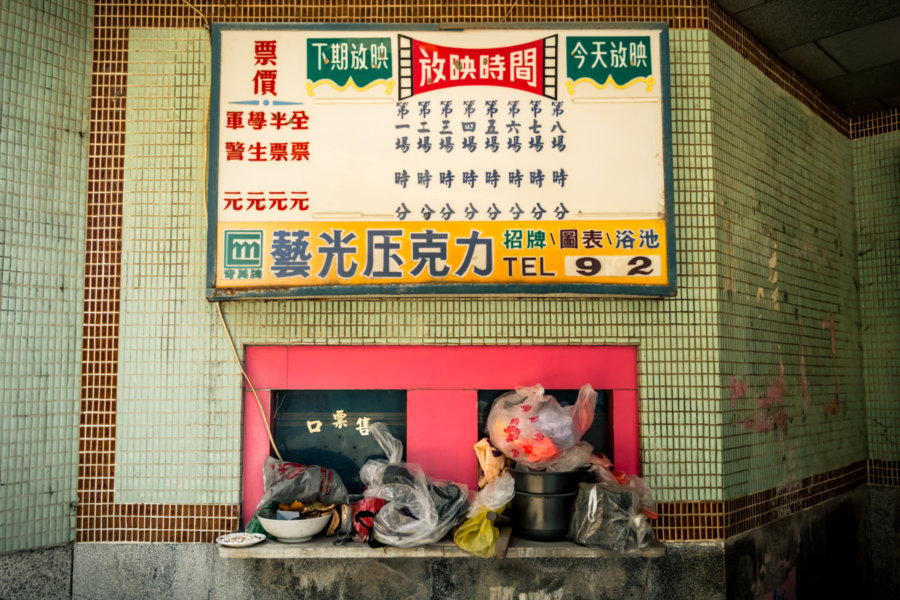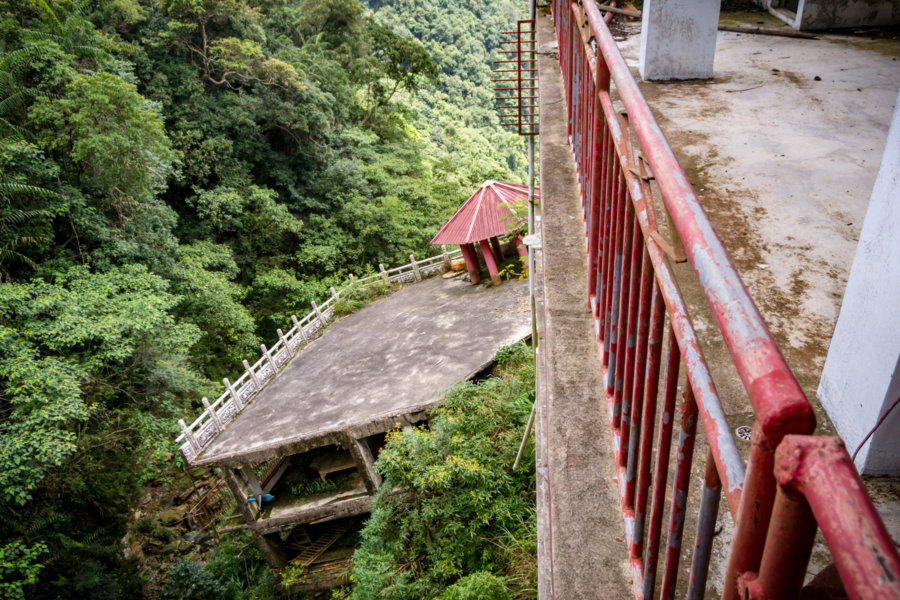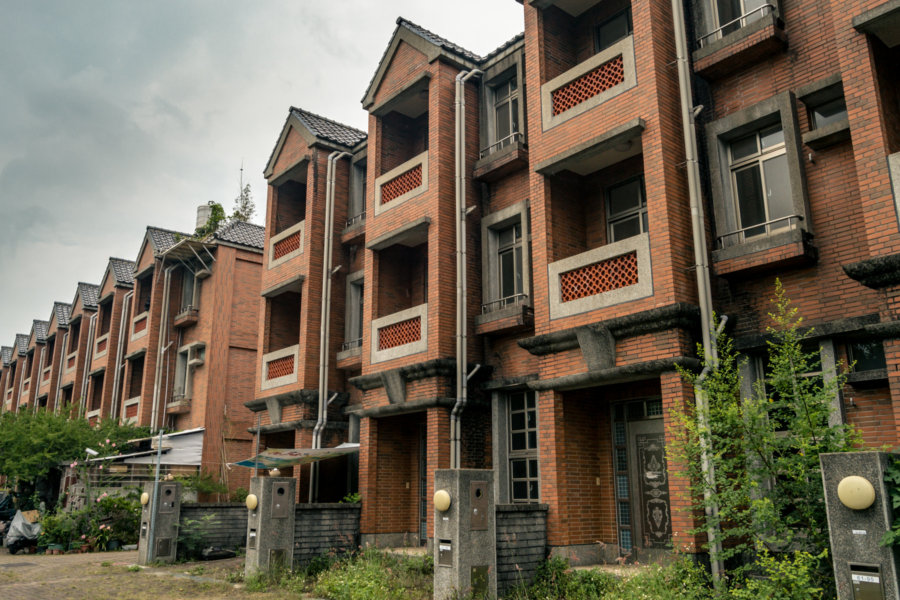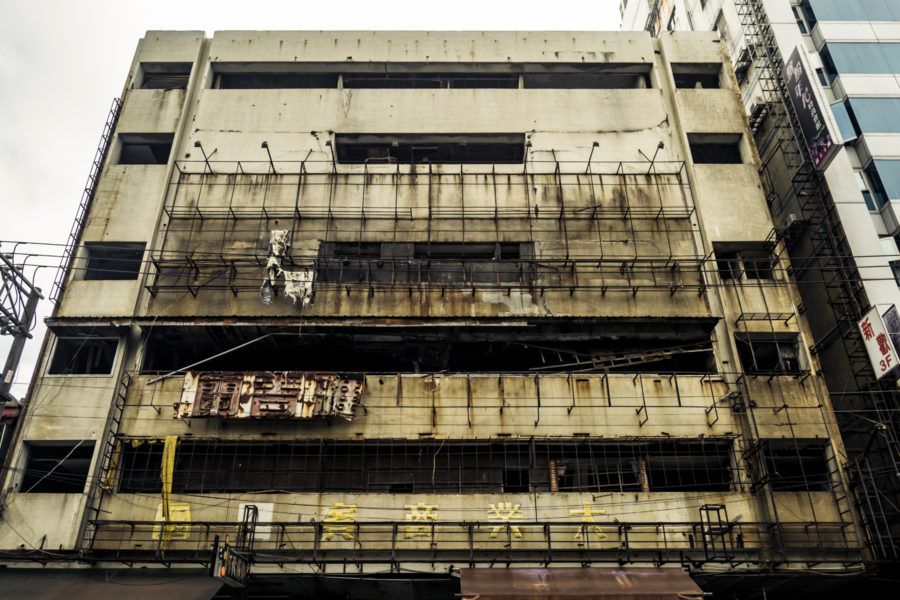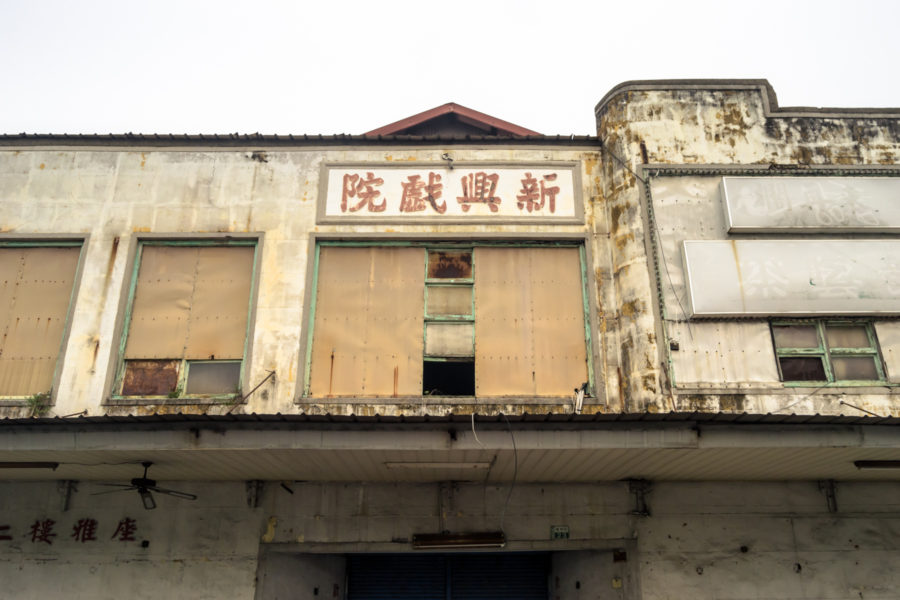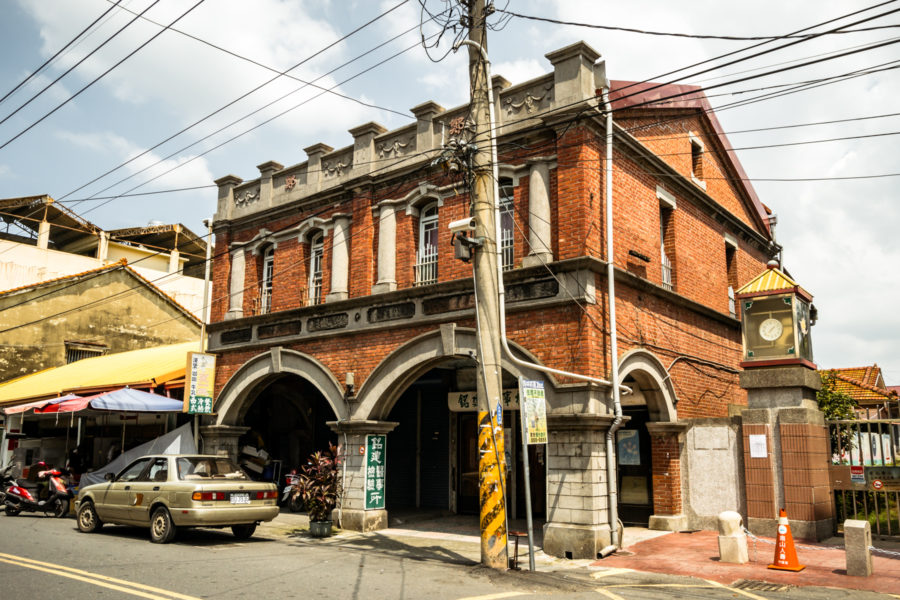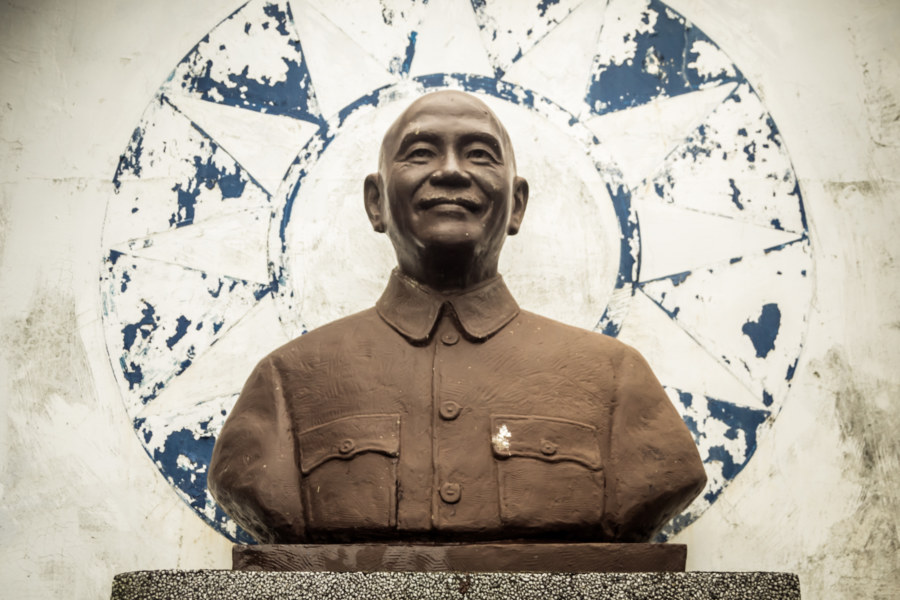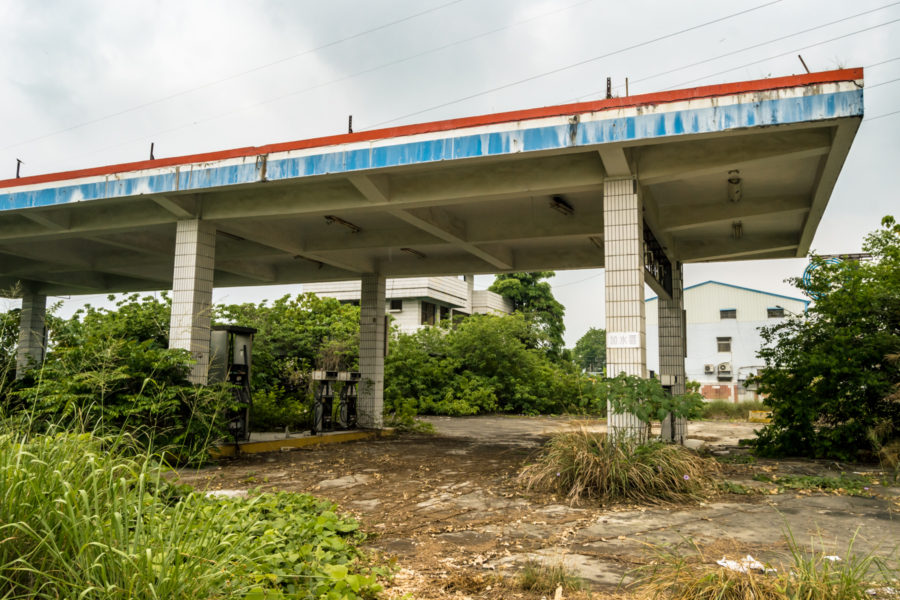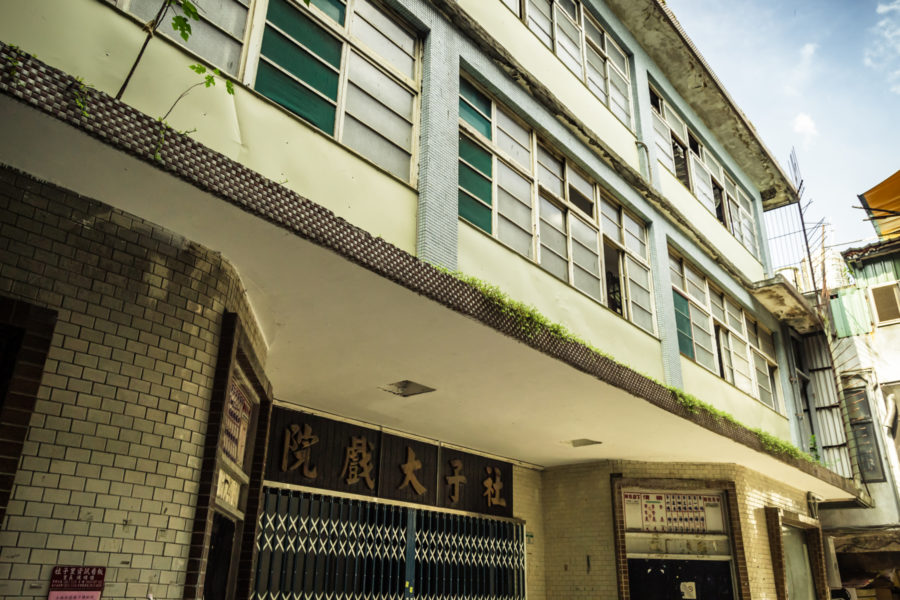Xiluo is a small historic town in rural Yunlin, Taiwan. Despite its diminutive size Xiluo was once home to three standalone movie theaters: the eponymous Xiluo Theater (西螺戲院), Yisheng Theater (一生戲院), and Yuǎndōng Theater (遠東戲院, literally “Far East Theater”), the subject of this brief report. Previously I misidentified Yisheng Theater as Yuandong, something I only learned after visiting a photo exhibition at Huashan 1914 Creative Park in 2017. After realizing my mistake I went to some lengths to locate and later visit this theater—which, in hindsight, I’ve passed on several occasions without noticing it down a small side street of the same name.
Lingxiao Temple 凌霄殿
The ruins of the former Língxiāo Temple 凌霄殿 can be found in the foothills of the Central Mountain Range 中央山脈 in Puli, Nantou. Likely named after the Chinese trumpet creeper, Campsis grandiflora (中文), it was founded in 1983 by local philanthropist Chen Chou 陳綢, famous across Taiwan for her charity work. The temple is quite remote, more than 10 kilometers down an old forestry road with no other exit, perched on the hillside at an elevation of 1,300 meters (for reference, the Puli Basin 埔里盆地 is around 500 meters above sea level).
Kezikeng New Community 柯子坑新社區
Located on the outskirts of Zhushan, Kēzikēng New Community 柯子坑新社區 is one of several public housing projects constructed in the aftermath of the 921 Earthquake that devastated central Taiwan in 1999. Despite providing much-needed relief for those who lost their homes in the disaster there were few buyers—and today the complex remains mostly empty and disused. Built with government funds, this poorly-conceived housing project has become yet another example of what Taiwanese call mosquito halls, a term popularized by artist Yao Jui-chung 姚瑞中 and a team of student researchers known as Lost Society Document. Since 2010 they have published six volumes of Mirage, a series of works identifying more than 800 disused public properties all around the country. Some of their work was translated into English—which is how I found out about this particular locale, which I briefly visited in the summer of 2017.
Guobin Commercial Building 國賓商業大樓
Guóbīn Commercial Building 國賓商業大樓 is an ugly ruin in the heart of Zhongli, a city of around half a million people in Taoyuan, Taiwan. Built at the dawn of the booming 1980s, it was home to a variety of entertainment businesses over the years, and appears to have been mostly abandoned sometime around the turn of the millennium. Much to my surprise I’ve not found much about this place online, which suggests whatever newsworthy calamities befell this derelict commercial building predate the era of digital journalism. Without any sources to draw upon I can only make some educated guesses about what I captured during a brief visit in the early days of 2017.
Dalin Xinxing Theater 大林新興戲院
What remains of Xīnxīng Theater 新興戲院 can be found just east of the train station in Dalin, a modest town of approximately 30,000 just north of Chiayi City in Taiwan. Despite its relatively small size Dalin once supported five movie theaters, providing entertainment for sugar factory workers and the many soldiers stationed at nearby military bases. Xinxing Theater (not to be confused with the one in Xinpu) originally opened as Rénshān Theater 仁山戲院 in 1954 and remained in business until 1992. Eventually the theater was renovated and subdivided into a billiards hall and KTV (also known as a karaoke box) before it was finally abandoned sometime around 2013. Recently there was talk of buying the property and transforming it into a creative market but its ultimate fate remained unknown until it was finally demolished in 2019.
Yicheng Cannery 義成罐頭工廠
The corpses of a thousand factories lay strewn across the plains of central and south Taiwan, stark reminders of an extraordinary period of economic growth in the latter half of the 20th century. Those located in more rural areas are readily forgotten and may remain derelict for years to come—but the more prosperous districts are busily excising these unsightly engines of economic growth from their urban landscapes. Progress is inconsistent, however, and it isn’t at all unusual to chance upon the hulking ruins of inner city factories that have yet to disappear. One such factory is the Yìchéng Cannery 義成罐頭工廠, an impressive complex hemmed in on all sides by residences in a network of winding alleyways not far from the train station in Yuanlin, the second-largest city in Changhua. No doubt this ugly eyesore will be demolished sometime in the near future—but in the meantime it has become a shadow world for local youth and curious outsiders such as myself.
Postcards From Ershui 二水明信片
Ershui is a rural township located in the southeastern corner of Changhua, bordering Yunlin and Nantou. Ershui Station 二水車站, constructed in 1935, is the primary point of transfer between the Main Line 縱貫線 of the Taiwan Railway Administration (TRA) and the Jiji Line 集集線, a tourist railway leading into the interior. Ershui, which literally means “two water”, is named after the Bābǎo Canal 八堡圳, an extensive system of artificial waterways still responsible for irrigating much of the Changhua Plain 彰化平原 three centuries after it was devised. During the Japanese colonial era this small town prospered as a center of woodworking while farmers in the countryside cultivated bananas, grapes, guava, and tobacco, among other crops. Nowadays it is mainly known as a sleepy stopover on the way to parts beyond—but a closer look will reveal several points of interest for anyone curious about Taiwanese history, architecture, and vintage style.
Hsinchu Xinyi New Village 新竹信義新村
Pictured here is a bronze bust of generalissimo Chiang Kai-shek in front of the faded emblem of the Kuomintang (KMT) in Xìnyì New Village 信義新村, a military dependents’ village in Hsinchu City. Chiang and the KMT retreated to Taiwan with more than a million Chinese soldiers and their dependents in 1949, bolstering an existing population of seven million Taiwanese. This instantly created a massive housing crisis—all those people needed places to live! The new regime attempted to address this through the development of hundreds of military dependents’ villages, gated enclaves of KMT soldiers and their families, but those were chaotic, desperate, and uncertain times, and many more ended up in informal and often illegal settlements all around Taiwan.
Nanyun Gas Station 南雲加油站
Nányún Gas Station (南雲加油站) is one of hundreds of abandoned gas stations found all around Taiwan. It was formerly affiliated with CPC Corporation (台灣中油), a state-owned enterprise that controls or supplies 80% of gas stations in the nation, and located on a section of Provincial Highway 3 in Yunlin known as Línshān Highway (林山公路), for it connects Linnei with Zhushan in neighboring Nantou. It was likely abandoned more than a decade ago, and for reasons that are less mundane than you might expect.
Shezi Theater 社子大戲院
Shèzi Theater 社子大戲院 was founded in 1965 as the first open-air theater in Taipei. Located in southwestern Shilin, it was a fairly informal venue from the sounds of it: an empty lot surrounded by bamboo fencing with films projected on a single screen for up to 500 people every night, stars wheeling overhead. Within three years of opening the owners reinvested some of their profits in filling out the space, adding a balcony level and some rudimentary shelter from the elements. Eventually the theater moved into a more permanent building on the same site, perhaps as late as 1976, when it first appears in business records. The rise of home video in the 1980s gravely impacted the theater business, leading the owners to divide the cinema into two halls, but there was no way to survive the new economy. Shezi Theater closed in 1996, another victim of changing consumer habits in Taiwan.
